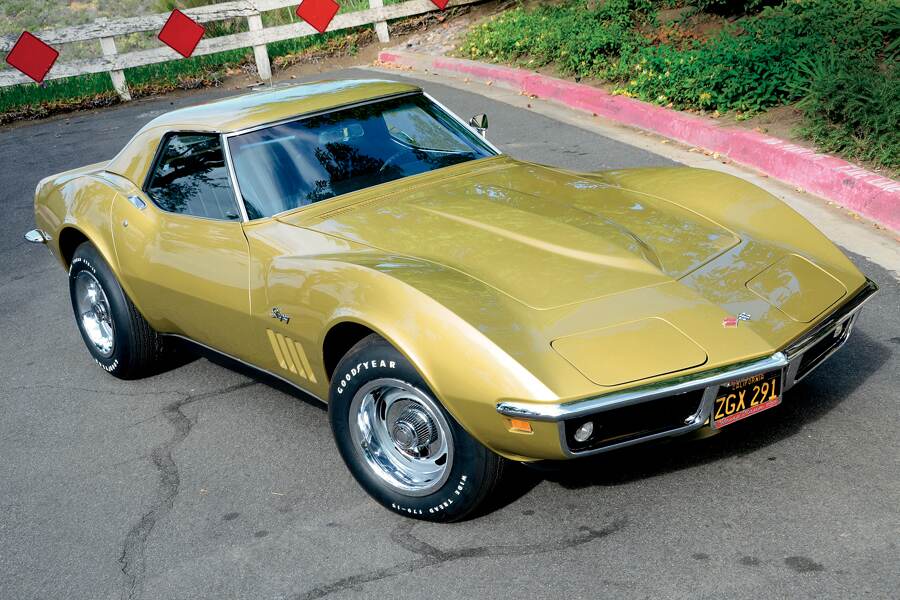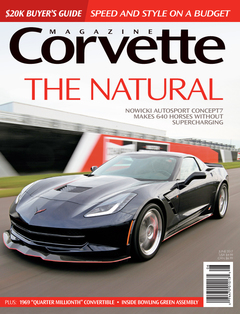Numbers are important, especially when it comes to tallying Corvettes. In 1953, only 300 were built. Things began to look up by the 1960 model year, when production first cracked the 10,000 mark. Interestingly, the highest number of Corvettes built in a single year was 53,807, in 1979—this, despite the later C3’s incorporation of wavy plastic bumper caps and a languid, 195-hp base engine. Also, we’ve previously featured the two ’92 editions—both white-on-red convertibles—that bracketed the identically outfitted one-millionth Corvette. Today, the total production tally for America’s Sports Car stands at more than 1.6 million and counting.
Yet what about another, lesser-known milestone, one that is nevertheless significant in Corvette history? That would be the 250,000th unit produced, a car nearly lost to time. What follows is the story of how this landmark ’69 convertible was rescued from an ignominious fate, along with some restoration details for anyone considering a similar project.
The car first rolled off the St. Louis production line on November 7, 1969 to much fanfare, with Miss Teen Missouri behind the wheel as part of GM’s “250,000 Corvette Milestone Celebration.” In a press release dated the day before, John Z. DeLorean, Chevrolet’s general manager at the time, declared that the Corvette’s total production surpassed the number of two-seat sports cars built under any other single nameplate to date. In typical marketing hyperbole, he added that, “The Corvette’s overall influence upon automotive trends and Chevrolet’s individual image goes far beyond the number actually built and sold.”

Public praise notwithstanding, the Corvette remained a borderline case for GM as far as profits were concerned, though building it was apparently still worth the strain. Why so? DeLorean explained at the time that, although the 250,000 figure was only a small fraction of the 40 million cars built by GM since 1953, the prestige the Corvette had achieved added luster to every Chevrolet passenger-car line.
The “Quarter-Mil Corvette” was eventually acquired by George Allen Dyer for the princely sum of $5,060 (not including fees and taxes). He took delivery from Harry Mann Chevrolet in Los Angeles on November 26, 1969. The specs were not extraordinary, but nonetheless appealing: 350/350 engine, four-speed close-ratio trans, standard trim, 3.70-geared Posi rear, auxiliary hard top, AM/FM pushbutton radio, Soft-Ray tinted glass and power windows.
The car was Dyer’s daily driver until 1982, when, inexplicably, he parked it in his garage, where it would sit unused for more than 30 years. Nobody knows why, but his brother Jack believes he merely grew disinterested, as he had several other grownup toys he’d relish for awhile and then put back “on the shelf.” George ultimately signed over the Corvette to Jack shortly before passing away, but by then the long-neglected car was showing the ravages of age and in desperate need of restoration.

The Challenge
“When we opened the hood for the first time in 30 years,” Jack recalls, “we found that there was a lot of dirt and surface corrosion on the engine and other mechanical components.” Worse yet, when he removed the air cleaner he discovered a large rat’s nest and even a petrified rodent lying in repose on the intake manifold. And, of course, the wiring, hoses and gaskets were all heavily deteriorated.
Fortunately, the interior was mostly just dirty, but otherwise in fairly good shape. Jack rebuilt the seats with new foam and covers, replaced the door panels and carpet, and subjected the rest of the cabin to a thorough cleaning. Ditto for the chassis, which only had some minor surface rust. But when Jack tried to move the car, he discovered that the parking-brake pistons had frozen in the cylinders and would not release the brakes. “This problem is very common for this model of Corvette with stock brakes [when they] sit unused for long periods of time,” he points out. Not only that, all four tires were flat and cracked and would not hold air.

Jack and son Michael, who’s part owner of the car, resolved to conduct a complete, frame-off restoration, with the goal of restoring the Corvette as closely as possible to its original, off-the-line configuration while using as many rebuilt or restored original parts as they could. They also wanted to ensure that all the part numbers matched and the date codes were correct. As a retired aerospace engineer, Jack has a meticulous approach to projects, so unsurprisingly he documented the entire process in precise detail.
Body and Chassis
Before he could start the frame-off project, Jack needed to transport the Corvette from George’s home to the restoration facility. To do so, he first replaced the old tires with cheap used ones, then broke the locked hand-brake pistons loose so that the rear wheels could rotate. He and Michael then rented a U-Haul trailer and loaded up the car for the 90-mile trip to a resto shop near Jack’s home in El Cajon, California.

Gene Townsend of Gene Townsend Enterprises began the job by removing the doors, hard top and hood. He then stripped off all of the old paint, right down to bare fiberglass, and repaired all of the defects in the body surface. This was followed by several coats of epoxy primer that were block sanded to provide a smooth, ripple-free surface.
The next step was to remove the body from the chassis. This involved first liberating the windshield, then attaching the body to a lift and hoisting it off the frame. The body was then placed on a custom movable stand that could be easily rolled around the shop. The plan was to restore the body and chassis in parallel, so after the engine and transmission were removed, the chassis was shipped to Van Steel Corvettes in Clearwater, Florida for refurbishing. For extra durability, the Van Steel crew powder-coated the frame rather than painting it. In addition to rebuilding the brakes, differential, suspension and steering components, they also added factory power steering and power brakes.
In the meantime, applying the correct hue of paint to the body proved to be a challenge. The original Riverside Gold lacquer finish was faded, making it harder to duplicate. Fortunately, Gene Townsend found some hidden areas where the factory paint had not faded. Using these areas as a reference, he was able to achieve a perfect match. For better durability, Jack decided to use a modern water-borne, base/clear paint system instead of lacquer.

Powertrain
Though the body issues were resolved, the engine would prove a whole ‘nother issue. Apparently, when George parked the Corvette in his garage, he neglected to prepare the car for long-term storage, so the water had not been drained from the cooling system. As a result, there was a lot of corrosion and other buildup in the system’s components and the engine’s water passages. Even worse, when removing the engine from the chassis for rebuilding, it was discovered that it was “frozen” and would not turn over. This problem was of great concern considering that the original, numbers-matching block might have been damaged and in need of replacement—a potential disaster for the provenance of this historic car.
With Jack’s fingers crossed, the engine went to Total Performance in Santee, California, a firm that specializes in building racing engines and rebuilding classic muscle-car motors. Upon pulling the cylinder heads, the shop’s technicians discovered that water had entered the cylinders and corrosion had frozen the pistons in place. Fortunately, they were able to carefully break the pistons free without damaging the cylinder walls. A .030-inch overbore was performed to clean up the wall surfaces, and all the deposits in the water passages of the heads and block were removed.

Another careful procedure had to be followed when surfacing the block. Normally, this is a simple operation involving a flat machine cut across the block surface. But in this case, doing so would eliminate the identification numbers on the cast tab at the back of the block. As a workaround, the technicians were able to perform the resurfacing by cutting at a slight angle, thus preserving the crucial numbers.
This high-performance engine originally had a compression ratio of 11:1 and required 100-octane gasoline, but Jack chose to replace the factory domed pistons with flat-top Mahle units that reduced compression to 10:1. This would enable the small-block to run on the 91-octane unleaded gasoline that is widely available in California. To improve durability and performance, Jack also replaced the original hydraulic flat-tappet cam with a custom-ground Crower hydraulic roller. The modern cam was designed to improve low- and mid-range performance while providing sufficient vacuum for the many vacuum-operated systems on the car. The original forged crank and piston rods were in excellent shape, requiring only an inspection and polishing of the bearing surfaces.
Also preserved was the stock Rochester four-barrel carburetor, which required only a rebuild, and the factory pressure plate, which was resurfaced. The transmission, meanwhile, was sent to specialist Jim Rupe in Tucson, Arizona for a full redo.

Jack admits that one of the most frustrating and time-consuming tasks during the restoration was finding correct engine belts and hoses. That’s because some of the 1969 high-performance small-block components were unique to that engine, so the standard belts and hoses would not fit. Also, since this was a late-1969 production vehicle, some of the parts used were different from the 1970 versions. In the end, Jack wound up buying many different pieces before being able to find the correct ones. The vacuum system was also a big headache, requiring many tedious hours of work to track down and eliminate leaks.
The entire exhaust system was replaced with a new setup from Gardner Exhaust Systems, Inc. in New York. For durability and looks, Jack went with an aluminized system rather than the original plain steel. The fuel system, including the lines, valves and tank, was also replaced.
Finishing Touches

Jack notes that literally every component on the car was removed, inspected and either cleaned and reused, repaired and reused, or replaced outright. For instance, George had replaced the original steel “Rallye” wheels with forged aluminum aftermarket rims. To return to the stock configuration, Jack tracked down a set of used ’69 Corvette 15×8-inch Rallyes bearing the correct date codes on eBay. (Fortunately, the stock Rallye spare was still with the car.) But the replacement rollers were worn and dented, so he had them straightened, grit-blasted, powder-coated and painted with the correct Argent Silver paint.
To be truly authentic, Jack also needed to use original bias-ply tires. A set of five reproduction Goodyear F70-15 Wide Ovals were sourced through the Kelsey Tire Company, which uses the original Goodyear molds. Rallye-wheel trim rings and chrome center sections were added to complete the look.
Overall, although the project took a lot more time and money than Jack originally estimated, careful, meticulous work by the restoration team produced precisely the result he was hoping for. “This car has a lot of meaning to me both historically and personally,” he says. “And it will be passed down to my son, so it will stay in the family.” Now that’s our kind of heirloom.






